Wonders of Iceland
A few of my favourite waterfalls and other places…
Iceland is a magical country with infinite places to go and things to do and see. Below is a list of natural wonders that I think take the top spots on a “must see” or ‘bucket list’ (in no particular order!).
On my trip to Iceland I was fortunate to visit all of these places with tips and tricks added on through recommendations from family and friends!
It is well known that Iceland is home to some of the most spectacular waterfalls on Earth. Here are 5 I would definitely recommend!
1. Gufufoss
This beautiful waterfall is located on the eastern side of the island. Situated near the little town of Seyðisfjörður, Gufufoss is the largest waterfall in the Seyðisfjörður fjord. Gufufoss is famous for its similarity to Skogafoss, another Icelandic waterfall but is a fantastic location in its own way. On my visit to Iceland, I sailed into Seyðisfjörður so this was the first waterfall I saw. I was immediately taken aback by the spectacular simplicity of this waterfall. The water, cascading from the lip above in a wall of silvery spray. The Icelandic landscape is incredibly dramatic, speckled with such beautiful but powerful natural wonders.
2. Rjúkandafoss
This waterfall is slightly further inland from Seyðisfjörður and holds the title of twelfth highest waterfall in Iceland. you can clearly see where the force of the water has carved its way through the rock, the three trails of water braiding in and out of eachother. Collectively, the waterfall reaches a height of 305 feet. This impressive height makes it a difficult waterfall to miss and it is also one of the only significant waterfalls that you can see from the primary Ring Road - main road number 1.
There is a great 15-minute walking trail from the road to the waterfall which is generally of an easy level.
3. Dettifoss
Dettifoss is the most powerful waterfall in Europe, with 500 cubic metres of water plummeting over the edge, every second!
It is 45m high and 100m wide and forms part of the ‘Diamond Circle’. This waterfall is very popular (for good reason) and is far more breathtaking in person than any video or photograph can capture. This is on the top om many ‘to-visit’ lists so, if you do decide to take a trip, I would definitely recommend taking a waterproof with you because if it’s windy, the spray can be quite unpredictable!
4. Goðafoss
Goðafoss is one of the most beautiful and history rich waterfalls in Iceland. It is located in Northern Iceland, lies in the river Skjálfandafljót and is made up of 3 ‘falls’. Goðafoss means ‘Waterfall of the Gods’ or ‘Waterfall of the Goði (priest/chieftain)’. After the commonwealth was established, there was pressure for iceland to convert to an entirely Christian country. The Ásatrú priest at the time, was given the responsibility of deciding the religious fate. Legend says he lay under a blanket and prayed to his Old Gods and when he eventually emerged, it was decided that for the good of the people, Christianity would be the official religion but Pagans could practice in private. To mark his decision, he traveled to the North and threws idols of the Old Gods into a beautiful waterfall, giving Goðafoss its current name.
5. Gullfoss
Gullfoss is named as the ‘Golden Falls’ because when the sun catches the water as it plunges down, it looks golden. The waterfall sits in the river Hvitá (white river) which originates in the glacier lake Hvítávatn (white river lake). Gullfoss is made up of two separate features. The first cascade flows down a three step staircase, approximately 11m tall, The water then plunges down in two steps into the 32m crevice beneath. Geologists believe that the 70m canyon was formed as a result of glacial outbursts from the beginning of the last age. Between 140 and 109 cubic metres of water surges down the fall every second depending on the season. It makes up part of the very popular ‘Golden Circle’ and there’s a good reason! This is definitely NOT one to miss!
Alongside the breathtaking waterfalls that Iceland is speckled with, there are hydrothermal pools, sulphur plains and incredible geological formations. a list of my personal favourites is below:
1. Þingvellir National Park
Þingvellir National Park holds great historical and geological significance. It is the first National Park in Iceland and was established in 1928. It is listed as a UNESCO world heritage site and holds universal value. Þingvellir Translates to “assembly plains”. The Icelandic parliament was established there around 930, meaning it is the oldest known parliament, in the world. many significant events have taken place at Þingvellir so it is seen as the ‘nation’s birthplace’.
The natural history of Þingvellir National Park is magnificent. it is formed in rift valley, dividing the North American and Eurasian continental plates. The lava fields have been fractured and torn by the tectonic movement, leaving colossal gorges and scars through the landscape. The rift valley holds a huge amount of water and hosts the largest natural lake in Iceland, Þingvallavatn. There are also many waterfalls along the rivers that flow into this lake.
There are various hiking trails and attractions throughout the national park. My favourite would be the bridge across the two plates where you can have one foot in Eurasia and the other in North America! For those of you who are keen outdoors enthusiasts and love a panoramic view, this is definitely the place for you. There is so much to see and do, and I would recommend planning ahead if you wish to partake in the diving, riding or angling that is offered. Þingvellir National Park is a true one of a kind location and one of the most impressive and breathtaking landscapes I have ever seen.
2. Námafjell
The Myvatn Geothermal area, (Námafjell), encompasses Lake Myvatn and the Hverir geothermal fields. There are natural steam vents and mud pools that surround the lake but the Hverir fields have the most impressive. The landscape is almost completely barron, making it feel ‘other-worldly’.
It is one of many geothermal plains in Iceland but is the largest and very easy to access. It sits right next to the primary ring road and the team clouds can be seen from miles away.
Even from the carpark, there is a strong smell of sulphur/fumarole gas accompanied by a hissing sound. These are the Fumaroles (natural steam vents). The concentration of sulphur in the vapours is not high enough to be dangerous but do be careful of the heat. They are incredible natural formations and in some places you can see that areas of the rocks are yellow or a light lime green. This is the more concentrated, solid sulphur that has formed on the exterior of the vents.
Mud pools are also scattered across the landscape. They form when a small volume of water collects in the volcanic ash that surrounds a fumarole. This creates a bubbling mud pool or mudpot which has an equally sulphurous smell as the vents.
In my opinion, this is one of the most exceptional landscapes that Iceland has to offer. The Sci-Fi-esque appearance of the location makes it one for the top of the bucket list!
3. Geysir
Geysir Geothermal area is one of the greatest natural attractions in Iceland. Home to a number of geysers and geothermal pools, it is understandably one of the most visited natural attractions in the world. ‘The Great Geysir’ has been inactive since 1916 when it suddenly stopped erupting and has remained dormant ever since. When it was active, it is said that it could shoot superheated water as high as 60-80m into the air. Although ‘The Great Geysir’ itself is inactive, the surrounding area in the Geysir region is speckled with hot springs and smalley geysirs. The central attraction of the area is now Strokkur (pictured left) which erupts approximately every 10 minutes, erupting 30m into the air. It is an incredible display of natural power and force and most certainly worth a visit. be sure to get to the front of the crowd to witness the full extent of the eruption. before the water shoots up, you can see it rising and bubble up towards the surface.
Surrounding Strokkur are multiple mud pools and pots, emitting sulphurous material, alongside steam vents, springs and primitive plants.
Overall, Iceland boasts some of the most incredible natural wonders in the world. It is no surprise that it receives so many visitors each year and if you ever get the chance to go, take it. There is something for everyone, and many locations that will be hard to beat!











